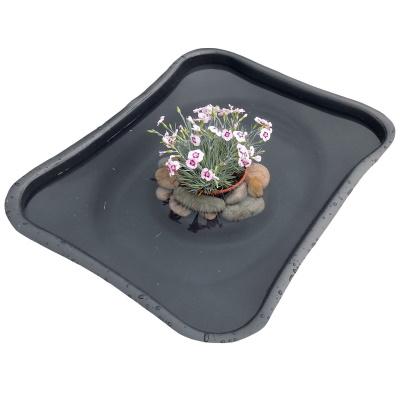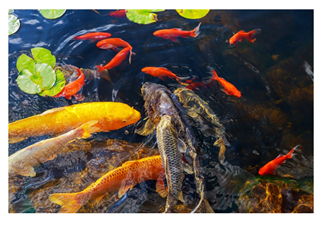How to create a Small Pond using a Container

Just like regular garden ponds, a small container pond can provide a lovely aesthetic to your garden, but it won’t be as costly! They are also very useful to the environment and wildlife, because of the benefits they provide.
You might also decide to use a small container as part of a series of ‘microhabitats’. These are areas of your garden which have different characteristics and provide different climates for wildlife; thus, encouraging great diversity right on your doorstep!
How to Create a Small Garden Container Pond (Useful Blogs: Pond Building Guide, Pond Plants, Top 5 Benefits of Solar Products)
1) Find the Right Container
Use any container you can find, from half barrels, buckets, troughs, or large bowls. The bigger the container, the more creative you can be. But try to avoid any containers that contain PFAS (polyfluorinated compounds) or BPAs (Bisphenol A), as these can leach harmful chemicals into your small pond. Clean the container and incorporate a small liner if it’s not waterproof.
The best materials to use include ceramic, fiberglass, non-porous stone like granite, and metals (such as aluminium & steel). These won’t break down over time like plastic, as they are more durable and long lasting. We sell a wide variety of preformed ponds; a popular choice at the moment is our PondXpert Preformed Pond (Wildlife).
2) Find the Right Location
Be sure to put your pond in a location that gets at least 6 hours of sunlight per day; it’s normal to put them on decks and patios where the pond will receive plenty of cooler sunlight on the morning.
Try to avoid putting the pond in direct sunlight in the summer; smaller ponds will heat up much quicker and this will cause problems.

3) Add Native Pond Plants
You should cover up to 50% of the container with plants to keep the water clean and aerated; this will reduce the likelihood of needing filtration equipment. Pond plants can be added via putting a substrate on the bottom of the pond; though most pond keepers will use a basket, soil, and gravel.
Depending on the size of the container, you should try to use a mixture of oxygenator plants, marginal plants, and floating plants. This provides plant diversity, shade, and an interesting aesthetic for your pond. Oxygenator plants need to be in a container that is greater than 30cm (1ft) in depth, while marginal plants require any depth greater than 20cm (8 inches).
4) Fill the Pond
Your container can now be filled! Try to use rainwater if you can. Alternatively, tap water can be used if you dechlorinate it (the PondXpert Tap Tonic can remove the chlorine, ammonia and add extra protection to your fish!). In both cases, please test the water first to check the balance. We sell both a Tetra Pond Test 6-in-1 and a Blagdon Pond Health Test Kit.
5) Maintaining the Pond
The maintenance on your pond will depend on its size. But in general, you should keep your plants trimmed back so they aren’t overgrown, perform partial water changes each month (20-50%) and test the pond once a month. In winter, the pond should be moved indoors to protect it from the icy weather. The Velda Duo Pond Scissors & Grabber includes a 1.8m (6ft) reach and includes both scissors to trim the plants and a grabber to remove the cuttings.
Do I need a Pump & Filter?
You do not normally need a pump or filter for these small, container ponds. However, a small sponge filter can be used if you notice the pond going cloudy. In most circumstances, pond plants are enough to keep the pond clean and clear.
You may find that a container pond is a magnet for mosquitoes, as they prefer still water for reproduction. An easy way to prevent this is to install a small solar pump to keep the water moving and to add aeration; this is enough to stop the pond from attracting mosquitoes.

Because of the size of the pond, it’s likely to hold up to 100 litres. This isn’t normally suitable enough for fish, because they produce a lot of waste which can lead to algae blooms, smelly water, and other problems.
If the container pond holds more than 225 litres (50 imperial gallons), you may be able to have a few small guppies, provided you use a small solar pump to keep the water aerated and circulating. Any fish that grow to a maximum of a 2 inches are classified as ‘small’. Try to avoid putting too many in to begin with; don’t forget that fish grow, and they reproduce!
Normal container ponds require a partial water change of between 20-50% per month. If you have fish in, this should be increased to once a month using dechlorinated water or rainwater.
You may also find the below blogs useful:
• Water Features
• Top Tips
• What can you do to help your local environment?
• Can you run a pond without electricity?
If you have any queries, please email us on info@pondkeeper.co.uk.